How Many Watts Does a Computer Use?
ZacharyWilliam“How many watts does a computer use?” is harder to answer than it looks, because a MacBook Air with a 30–35W USB-C adapter is nothing like a 700W+ gaming desktop. To size a UPS, portable power station, or solar generator correctly, you need to know which type of computer you’re dealing with, and whether we’re talking about the charger rating or the real draw while working.

1. Why Computer Wattage Varies So Much
Computer wattage is mainly decided by these factors:
- Form factor – ultra-slim laptops pull 30–65W, while performance desktops are sized for 500–1,000W PSUs.
- CPU / GPU class – integrated graphics or Apple silicon = lower watts; RTX 50-series / high-end Radeon = much higher watts. HP’s current OMEN 45L with top GPUs is designed for 500–700W under load and often ships with 800–1200W PSUs. HP, HP PSU guide.
- Adapter vs. real draw – Apple’s 24-inch iMac ships with a 143W adapter, but real-world draws can sit around 80–100W because Apple leaves headroom for USB-C ports. Apple iMac specs, Apple what’s included.
- Workload – idle / browsing is usually a small fraction of the adapter label.
So: the number printed on your charger = the maximum it can safely deliver, not “what your computer always uses”.
2. Typical Wattage Ranges by Computer Type
Ultrabooks / MacBook Air / thin-and-light (30–65W): e.g. MacBook Air (M3, 13") comes with a 30W or 35W adapter, and can fast-charge with 70W if needed. Apple spec, Apple adapter guide.
Work / creator laptops (90–140W): e.g. Dell XPS 15 uses a 130W adapter. Dell.
All-in-one PCs (90–150W): e.g. 24-inch iMac comes with a 143W power adapter. Apple iMac.
Office / business desktops (120–300W real use): often far below PSU rating because most office tasks are light.
High-end / gaming desktops (500–700W under load): HP shows OMEN 45L systems using roughly 500–700W in gaming, with PSUs up to 800–1,200W for GPU headroom. HP, HP 800W PSU.
3. Popular Models & Wattage Table (with Sources)
Below is a 2025-updated snapshot from official spec pages or vendor guides.
| Device / Brand | Adapter / Max Listed | Typical Real-World Use | Source |
|---|---|---|---|
| Apple MacBook Air (13", M3) | 30W or 35W USB-C adapter | Browsing / docs often 10–25W; jumps when charging or using external devices. | Apple tech specs |
| Apple MacBook Pro 14" (M4 / 2024–25) | 70W USB-C adapter (96W for higher config) | Office 15–35W, video / compiling higher, full charge + load closer to adapter. | Apple MBP 14 |
| Lenovo ThinkPad X1 Carbon (USB-C) | 65W USB-C AC adapter | Light work 15–30W; peaks when charging battery + CPU load. | Lenovo 65W |
| Dell XPS 15 (2025 family) | 130W USB-C / 130W barrel | Creator workloads 60–100W; heavy GPU / charging pushes toward 130W. | Dell spec |
| Apple iMac 24" (M-series) | 143W power adapter | Web / office often <100W because adapter has extra headroom for USB-C / Ethernet. | Apple iMac |
| HP OMEN 45L / Max 45L (RTX 50-series) | 800–1,200W PSU options | Gaming load often 500–700W; idle/light 60–100W. | HP power draw |
| HP Pavilion / midrange Windows laptop | 90W smart AC adapter common | Normal work 20–45W, gaming spikes higher. | HP charger |
Always check the label on your own adapter or System Information panel — vendors refresh power bricks over time.
4. How to Measure Your Own PC’s Watts
If you want exact numbers, do this:
- Use a plug-in watt meter (Kill-A-Watt style) between wall and PC.
- Test three scenarios: idle / web, your heaviest real task (video edit / game / CAD), and charging (for laptops).
- Write down the highest number → this is what you must cover with a power station / UPS.
If the peak number is 360W, don’t buy a 300W inverter — go for 500–600W to avoid overload.
5. How Long Will a Computer Run on a Power Station?
Use this quick formula:
Runtime (hours) = Battery capacity (Wh) × 0.85 ÷ Computer watts
We multiply by 0.85 to account for inverter/AC losses.
Example A – 60W laptop + UDPOWER C400
- UDPOWER C400: 256Wh, up to 800W max output.
- Runtime: 256 × 0.85 ÷ 60 ≈ 3.6 hours of real work.
Example B – 130W creator laptop (Dell XPS 15) + UDPOWER C600
- UDPOWER C600: 596Wh, 600W rated, 1,200W surge.
- Runtime: 596 × 0.85 ÷ 130 ≈ 3.9 hours → easily a half day of mobile editing if you mix in idle time.
Example C – 300W small desktop / all-in-one + UDPOWER S1200
- UDPOWER S1200: 1,190Wh, 1,200W AC, <0.01s UPS, LiFePO₄.
- Runtime: 1,190 × 0.85 ÷ 300 ≈ 3.4 hours of continuous work.
6. Quiet Backup Options from UDPOWER (Light Recommendation)
UDPOWER S1200 – 1,190Wh, 1,200W (1,800W surge mentioned in product notes), LiFePO₄ 4,000+ cycles, 5 AC outlets, <0.01s UPS, good for desktops, iMacs and monitors together. Official page.

UDPOWER C600 – 596Wh, 600W, 1,200W surge, 12.3 lbs, ideal for high-power laptops and mini PCs. Official page.

UDPOWER C400 – 256Wh, up to 800W max output, very portable, perfect for MacBook / ThinkPad / iPad + router during short outages. Official page.

These are quiet, indoor-safe, and match the wattage ranges in the table above — but the article remains mainly about figuring out your computer’s watts, not about the product itself.
7. FAQ
1) Why does my adapter say 143W / 140W but my meter shows less?
Manufacturers size adapters for peak + peripherals. Real CPU/GPU draw is often lower. Apple’s iMac example is exactly this.
2) Do gaming PCs really use 600–700W?
Yes — if you have a modern high-end GPU and play at high settings, HP’s own 2025 OMEN guides show 500–700W under load.
3) Can I run a desktop on a 600W portable power station?
Yes, if the desktop’s real use is <600W and the station’s inverter is 600W pure sine (UDPOWER C600 matches this). Leave some headroom for monitor/peripherals.
4) How do I size for a whole workstation (PC + monitor + router)?
Add the highest real draw of each device, then apply 15–20% headroom. Example: 200W PC + 30W monitor + 10W router ≈ 240W → pick 300–600W inverter & 500–600Wh battery.
5) Why do MacBooks seem so low-watt?
Apple silicon is efficient; many MacBooks ship with 30–70W adapters but still deliver performance.


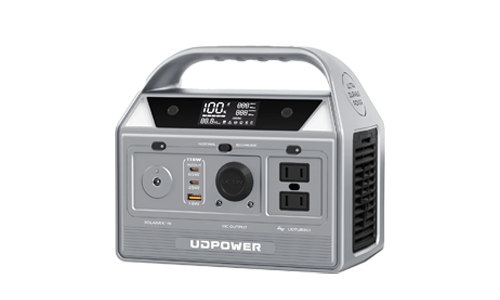
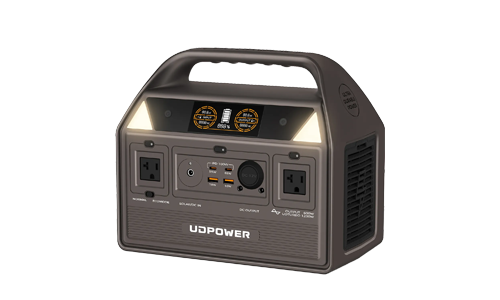
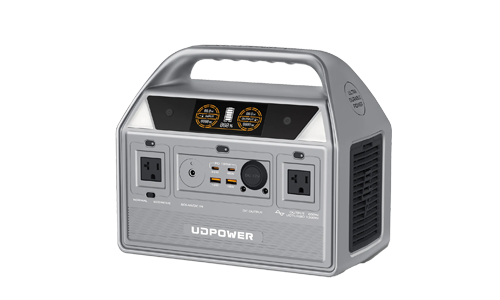


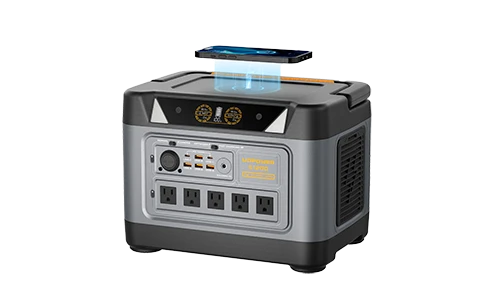



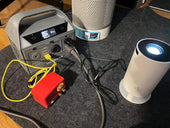
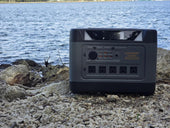
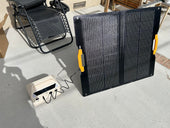

























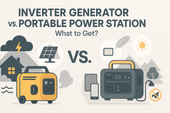
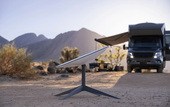








![How to Live In The Woods [Complete Guide]](http://udpwr.com/cdn/shop/articles/Off-Grid_Cabin_Option_f6c94fe7-1ae7-4c3a-baf5-ed9fe684c832.png?v=1763523215&width=170)




